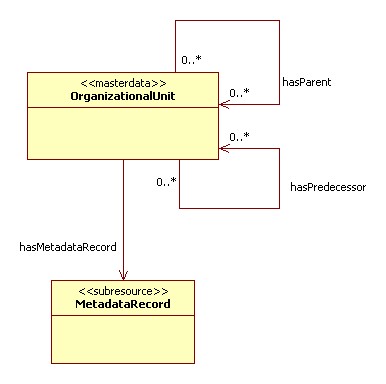ESciDoc Logical Data Model/Organizational Unit
Jump to navigation
Jump to search
Introduction[edit]
This page provides general overview on the Organizational unit entities within the eSciDoc repository. General introduction available at eSciDoc Logical Data Model page.
Model description[edit]
- An Organizational unit represents entities such as a society, institution, department, project, virtual organization; eSciDoc organizational units hold information on their organizational structure and organizational history i.e changes of the organizational structure during time such as: fusion, splitting, spin-off and replacement (for more details, see PubMan_Func_Spec_Organizational_Unit_Management#General_rules and organizational unit history)).
- An organizational unit may be referenced in other resources (content resources or master data) such as:
- as an affiliation of the author in the metadata of e.g. journal article
- as a selector for definition of a user group, to allow access to content to members of a certain institution only (institutional visibility)
- as a responsible organization for the content resources managed within a Context
- as an organizational unit to which a certain eSciDoc user account is primarily associated. Note that the latter highly depends on how the user account management is implemented within an eSciDoc core-services instance.
UML Diagram[edit]
- For simplicity reasons properties of the objects are not represented on the diagram. Properties are managed by the escidoc repository itself and may change during time. For more information on the properties and ther usage please check the documentation available at eSciDoc Organizational Units Service.
Examples[edit]
Top level organizational unit[edit]
A top level is an organizational unit that has no parent organizational units associated. It may have any number of child organizational units associated.
Child organizational unit[edit]
A child organizational unit has at least one parent organizational unit associated. It may have any number of child organizational units associated.
